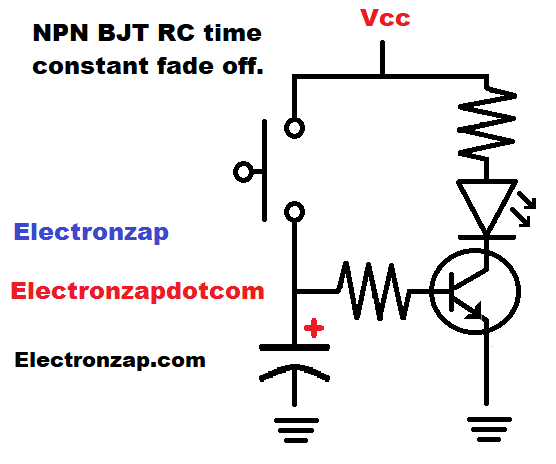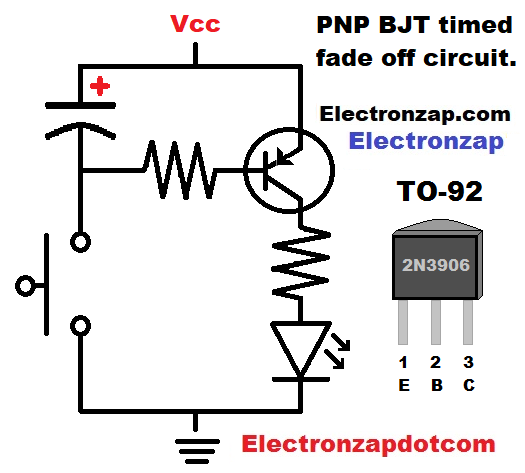Table of Contents
Capacitors can store enough energy to keep a Bipolar Junction Transistor (BJT) from turning off fully for a while.

- Closing the switch charges the capacitor instantly and turns the transistor on.
- Current flows through the base resistor and then through the emitter to ground.
- Most NPN BJTs have a gain between 100 to 300. Therefore a small amount of base current will allow up to at least 100 times that amount of current to flow from collector to emitter. That same current flows through the series load between Vcc and the collector.
- The transistor will conduct better than the load. So, the load will be what limits the current. The NPN BJT is an on switch for at least as long as the push button switch is closed.
- Releasing the switch means the capacitor has to provide the base current.
- Less current is provided while the capacitor discharges. So, once the NPN BJT is not conducting better than the load, then the LED will keep fading down until it is off completely.
- More supply voltage and/or a larger capacitor will mean a longer time that it takes for the LED to fade off for a given base resistor.
Video:
PNP version:

- Closing the switch charges the capacitor instantly and turns the transistor on.
- Current flows from the PNP BJT emitter to base and through the base resistor, which can usually be large enough value to only pass about 1% of the current that the load will need.
- Most PNP BJTs will allow over 100 times as much current to flow from emitter to collector as what is flowing through emitter to base. The load from collector to ground will be what actually sets how much current flows, based on the supply voltage and the load.
- Opening the switch allows the capacitor to discharge through the emitter-base and the base resistor.
- Less current flows through emitter to base as the capacitor discharges. Most PNP BJTs allow 100 to 300 times as much current to flow through the emitter to collector as is flowing from emitter to base. So the LED stays well lit for a while, but gets more dim over time. At some point it will be off completely.
- The more supply voltage and the larger the capacitor capacitor will result in a longer fade off time.
Video:
To support this site, check out the following links:
- Become a Patron!
- Check out my YouTube videos! https://www.youtube.com/c/Electronzap/videos
- Products I used in my videos or otherwise think look like a good buy. As an Amazon associate, I earn from qualifying purchases. https://www.amazon.com/shop/electronzapdotcom
- Information on this site is not guaranteed to be accurate. Always consult the manufacturer info/datasheet of parts you use. Research the proper safety precautions for everything you do.
- Electronzap is a participant in the Amazon Services LLC Associates Program, an affiliate advertising program designed to provide a means for sites to earn advertising fees by advertising and linking to amazon.com.